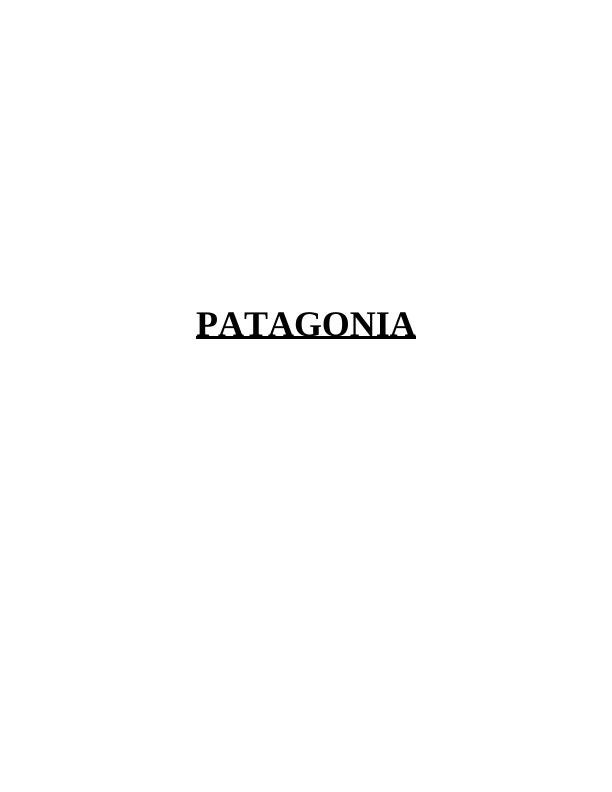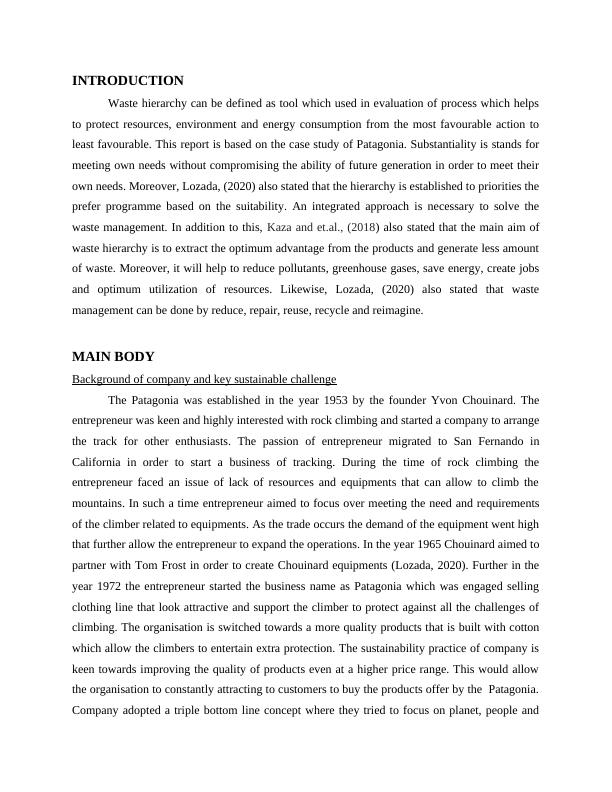Patagonia: Sustainable Waste Management Practices
Added on 2023-06-17
7 Pages1536 Words112 Views
PATAGONIA

Table of Contents
INTRODUCTION...........................................................................................................................3
MAIN BODY..................................................................................................................................3
Background of company and key sustainable challenge.............................................................3
By using the waste hierarchy pyramid, the current practices of Patagonia is discussed.............4
CONCLUSION................................................................................................................................5
REFERENCES................................................................................................................................1
INTRODUCTION...........................................................................................................................3
MAIN BODY..................................................................................................................................3
Background of company and key sustainable challenge.............................................................3
By using the waste hierarchy pyramid, the current practices of Patagonia is discussed.............4
CONCLUSION................................................................................................................................5
REFERENCES................................................................................................................................1

INTRODUCTION
Waste hierarchy can be defined as tool which used in evaluation of process which helps
to protect resources, environment and energy consumption from the most favourable action to
least favourable. This report is based on the case study of Patagonia. Substantiality is stands for
meeting own needs without compromising the ability of future generation in order to meet their
own needs. Moreover, Lozada, (2020) also stated that the hierarchy is established to priorities the
prefer programme based on the suitability. An integrated approach is necessary to solve the
waste management. In addition to this, Kaza and et.al., (2018) also stated that the main aim of
waste hierarchy is to extract the optimum advantage from the products and generate less amount
of waste. Moreover, it will help to reduce pollutants, greenhouse gases, save energy, create jobs
and optimum utilization of resources. Likewise, Lozada, (2020) also stated that waste
management can be done by reduce, repair, reuse, recycle and reimagine.
MAIN BODY
Background of company and key sustainable challenge
The Patagonia was established in the year 1953 by the founder Yvon Chouinard. The
entrepreneur was keen and highly interested with rock climbing and started a company to arrange
the track for other enthusiasts. The passion of entrepreneur migrated to San Fernando in
California in order to start a business of tracking. During the time of rock climbing the
entrepreneur faced an issue of lack of resources and equipments that can allow to climb the
mountains. In such a time entrepreneur aimed to focus over meeting the need and requirements
of the climber related to equipments. As the trade occurs the demand of the equipment went high
that further allow the entrepreneur to expand the operations. In the year 1965 Chouinard aimed to
partner with Tom Frost in order to create Chouinard equipments (Lozada, 2020). Further in the
year 1972 the entrepreneur started the business name as Patagonia which was engaged selling
clothing line that look attractive and support the climber to protect against all the challenges of
climbing. The organisation is switched towards a more quality products that is built with cotton
which allow the climbers to entertain extra protection. The sustainability practice of company is
keen towards improving the quality of products even at a higher price range. This would allow
the organisation to constantly attracting to customers to buy the products offer by the Patagonia.
Company adopted a triple bottom line concept where they tried to focus on planet, people and
Waste hierarchy can be defined as tool which used in evaluation of process which helps
to protect resources, environment and energy consumption from the most favourable action to
least favourable. This report is based on the case study of Patagonia. Substantiality is stands for
meeting own needs without compromising the ability of future generation in order to meet their
own needs. Moreover, Lozada, (2020) also stated that the hierarchy is established to priorities the
prefer programme based on the suitability. An integrated approach is necessary to solve the
waste management. In addition to this, Kaza and et.al., (2018) also stated that the main aim of
waste hierarchy is to extract the optimum advantage from the products and generate less amount
of waste. Moreover, it will help to reduce pollutants, greenhouse gases, save energy, create jobs
and optimum utilization of resources. Likewise, Lozada, (2020) also stated that waste
management can be done by reduce, repair, reuse, recycle and reimagine.
MAIN BODY
Background of company and key sustainable challenge
The Patagonia was established in the year 1953 by the founder Yvon Chouinard. The
entrepreneur was keen and highly interested with rock climbing and started a company to arrange
the track for other enthusiasts. The passion of entrepreneur migrated to San Fernando in
California in order to start a business of tracking. During the time of rock climbing the
entrepreneur faced an issue of lack of resources and equipments that can allow to climb the
mountains. In such a time entrepreneur aimed to focus over meeting the need and requirements
of the climber related to equipments. As the trade occurs the demand of the equipment went high
that further allow the entrepreneur to expand the operations. In the year 1965 Chouinard aimed to
partner with Tom Frost in order to create Chouinard equipments (Lozada, 2020). Further in the
year 1972 the entrepreneur started the business name as Patagonia which was engaged selling
clothing line that look attractive and support the climber to protect against all the challenges of
climbing. The organisation is switched towards a more quality products that is built with cotton
which allow the climbers to entertain extra protection. The sustainability practice of company is
keen towards improving the quality of products even at a higher price range. This would allow
the organisation to constantly attracting to customers to buy the products offer by the Patagonia.
Company adopted a triple bottom line concept where they tried to focus on planet, people and

End of preview
Want to access all the pages? Upload your documents or become a member.
Related Documents
Sustainable Business Management: Key Challenges and Waste Hierarchylg...
|7
|1778
|193
